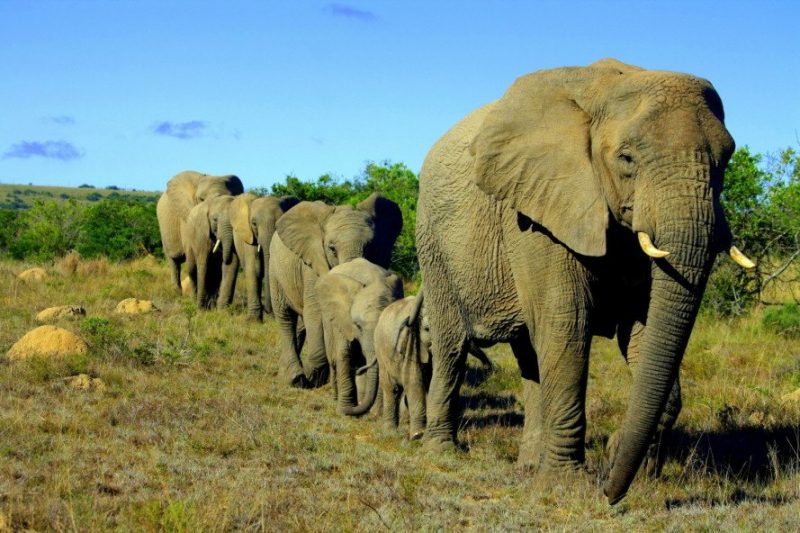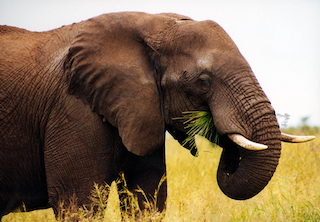Memory Serves Better For Matriarch Elephants
The multi-generational families of elephants in the wild can typically contain up to 10 members that move together as one unit searching for food, defending each other and caring for their offspring. This extended family structure is called herd with the oldest female elephant called matriarch, in charge. She leads the pack and controls the daily activities of its members. The matriarch elephant in the herd is also the most experienced family member. In critical moments, the entire group relies on the experience of the oldest female. The wealth of experience of the matriarch is due to her photographic memory and the ability to retain superior memories for several decades. Those sharp memories sometimes even last a whole lifetime.
Memory based behavior
Proof of the remarkable lasting memories lies in the possessive behavior of the matriarch elephant. Studies have found that she alerts the rest of the herd when confronted by everyday dangerous situations or when sensing the presence of predators nearby. She even leads and directs the team if she recognizes an old feeding site as she can recall important locations, even if they had not visited those places for many years. The memories they possess of water holes and feeding spots along the migration routes previously taken are remarkable. The members of the herd just have to look at the mother elephant in times of trouble, danger, and emergency as she will remember what to do and where to go.
Conflict avoidance behavior
Matriarchs will huddle in protective posture when met with an unfamiliar elephant because they realize that those strange elephants could conflict with the security of the herd. One study by Dr. Karen McComb, an animal behaviorist, and her colleagues at the University of Sussex in England showed that when faced with a stranger elephant, the 55-year-old female elephant was more likely to crouch in a defensive position than the 35-year-old female elephant. The conflict avoidance behavior is because the older ones were more likely to have experienced a stranger who conflicted with a herd before. In other words, the older matriarchs were aware such outsiders would start conflicts and possibly harm the calves. The remembrance helps in survival because they now know what needs to be done to defend themselves and warn the stranger.
Threat mitigating behavior
When 39 families of elephants in Amboseli National Park in Kenya involved in a study heard 72 playbacks of the sound of a lion roaring in loudspeakers over more than two years, those with older matriarchs listened intently to male roars for longer periods. They then led the herd members into safety because they sense the threat more intuitively than others. Older females are capable of holding a store of social knowledge. Over a period, these female elephants build up a great memory cache that enables them to remember predators, enemies, and friends. Therefore, aged elephants are capable of making critical decisions about predators. This skill is because of their experience in meeting similar peril before.
Sustenance finding behaviour
Studies have shown that matriarch elephants who have experienced droughts before will lead their groups to more fertile land. Younger matriarch elephants who haven’t yet lived through a dry spell are more likely to remain behind.
During a particularly severe drought in 1999 at the Tarangire National park in Tanzania, researchers and scientists from the Wildlife Conservation Society in New York City studied three herds of elephants. They found that the elephants not only recognize each other but also recall alternate routes to food and water sources. When the resources dried up, two herds left the park. Each of those groups had matriarchs between the age group of 38 and 45. In other words, the pachyderm groups with older matriarchs left the parched park in search of food and water. But the one group that stayed put had a younger female elephant of 33 years of age. As a result, there was an 18% increase in the mortality rate among the calves who remained behind. Of the sixteen young elephants who died during the dry spell, ten were from the group that stayed put.
Previous drought helped
Researchers found out that there had been another drought in the area in 1958 that lasted for three years, meaning that older matriarchs would have been five years old at the time. They likely remembered the event and how their herds survived it by migrating to lusher areas. They had a better knowledge of where to go when the natural water and food resources dried up. Hence, during the second drought, they headed on the familiar path, which seems to demonstrate high cognitive thinking. The younger matriarch in the third group wasn’t aged enough to remember it and didn’t know where to go. If the elephants had survived a drought in childhood, they would have had a good grasp of the danger of drought.
Mental mapping memory
Elephants are known to have an incredible ecological memory and can travel to far off places in search of water and food. They can remember many remote water sites which are several thousands of kilometers apart shortly after the rains. Sometimes they use tracks which have not been used for several years, highlighting the mental mapping memory of the matriarch. They depend on the long-term memory of their previous travel on those routes.
Longevity and leadership
The researchers said the ability of the oldest matriarchs to avoid conflict, mitigate the threat, and find sustenance highlights the advantage of longevity and the importance of age in leadership in large-brained mammals. The research also indicates that prey species with large brains compared to their body size can more effectively adjust their defensive responses to specific encounters and are thus better at evading predators. That is why clans with old members have a high rate of survival. But sadly, poachers often target her for the ivory tusks as they are the largest in the herd of females. The death of the matriarch of the herd is always a tragic loss for the group.
Beneficial evolutionary trait
The ability of elephants to recall their peers and human beings from the past serves them well as they can live up to 70 to 80 years. The amount of time spent together does not have any bearings on their recollection capability. Not only are they able to recognize peers and people, but also express emotions in ways that perhaps only human beings can. They can pinpoint familiar peers using their incredible sense of smell and to detect the contact appeal emitted while meeting. But it is yet to be confirmed whether they use the same faculty and mechanism to recognize humans. Further studies in the future might shed some light on it.
5 Frequently Asked Questions About Elephant Matriarch
To receive a colourful digibook about elephant with videos, images and text, please fill out the following form or simply email us on safaris@safari-center.com








